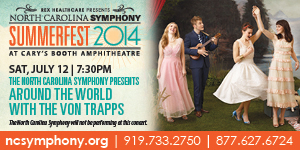This is the fourth season of concerts by Baroque and Beyond, presented by the Preservation Society of Chapel Hill in some of the village’s historic properties. Founded by harpsichordist Beverly Biggs, the ensemble consists of a flexible configuration of period instrument players from within the state and beyond. This concert, like most of them, took place in the intimate confines of adjoining rooms in the Horace Williams House. While the series explores music from the 1600s through the early 1900s, the focus of this program was cantatas of George Philipp Telemann (1681-1767), leavened with bits of Bach and Handel.
The musicians were sopranos Penelope Jensen and Florence Peacock, two of Chapel Hill’s most beloved performers, with baroque violinist Leah Peroutka, from Greensboro, and oboe and recorder player William Thauer, who has been active nationally before and since moving to North Carolina in 2006. The essential continuo role was taken by harpsichordist Biggs along with baroque cellist Stephanie Vial. Our state abounds with historically informed players active throughout the nation.
Telemann’s cantata “Pache dich, gelähmter Drache” (Be gone, crippled Dragon) for soprano, violin, and continuo, TWV 1:1222, is from one year’s set of 72 cantatas for solo voice in Der Harmonische Gottesdienst published in 1725-26. Based upon the three cantatas sampled in this concert, Telemann seems to structure his in a pattern of arias sandwiching extensive recitatives in the form of extended reflections upon liturgical reading. J. S. Bach is more succinct with the recitatives and more expansive with arias. Before beginning to sing, Peacock passed to the audience a contemporary icon in the old style on the imagery of this cantata, the Battle of St. Michael and the Dragon. The program included only the English translations. Clear diction and great care for the words were characteristic of Peacocks’ very bright singing of the arias and the recitative comparing the Battle to the believer’s own internal struggle between good and evil. Leah Peroutka’s violin blended and supported the vocal line beautifully, set against Bigg’s firm playing of the base line.
Oboist Thauer and violinist Peroutka turned in a lively and stylish performance of Handel’s Trio Sonata in D for Oboe, Violin, and Continuo, HWV 381. Thauer’s mellow, warm tone was winning and the contrasting and pairing of the oboe and violin lines were enjoyable. Biggs and Vial ably supported their playing of the well-sprung rhythms of the fast movements.
Telemann’s cantata “Seele, lerne dich erkennen” (Learn to know yourself, oh soul) for soprano, recorder and continuo, TWV 1: 1258 featured a bit of musical ornithology with Thauer’s recorder “chirping” away joyfully during the long recitative’s metaphor about a little bird with trembling feathers. Penelope Jensen, who has long set vocal standards high, sang expressively with a fine, warm tone. Her diction was a master class in how it should be done.
Four short excerpts from instrumental and vocal works of J.S. Bach were given after intermission.
Peacock delivered the enigmatic soprano aria “Höchster, was ich habe” from Cantata 39 Brich dem Hungrigen dein Brot with lovely simplicity. This was followed by a beautifully paced performance of the Andante from Sonata in G minor, S. 1034 by Vial and Biggs. Vial produced a robust baritone tone for the contrasted Menuets I and II from the Cello Suite in G, S. 1007. Peacock was joined by violinist Peroutka and Thauer on recorder for a loving performance of the famous “Schafe können sicher weiden” (Sheep may safely graze) from The Hunt Cantata, S. 208.
Handel’s Sonata in D for Violin and Continuo, HWV 371 served a fine showcase for the fine intonation, stylish phrasing, and warm tone of violinist Peroutka. The fast movements were beautifully inflected and the two slow movements displayed her ability to sustain an elegant, flowing line.
Telemann’s cantata “Schmeckt und sehet unsers Gottes Freundlichkeit” (Taste and see the friendliness of our God!), TWV 1:1252 was composed for the Sunday after the New Year and is the most structurally complex of the three on this program. The first aria leads to a recitative-sermon on forgiveness and grace. A short arioso pairs the soprano and oboe. A further sermon-recitative on forgiving our neighbor as God forgives us leads to fiery aria threatening vengeance if forgiveness is not given. Jensen’s focused tone and precise German diction were winning as she dealt with the melismas and word-painting in the virtuoso final aria. Oboist Thauer’s agile and articulate playing contributed greatly to the fast-paced, intense and stormy last aria, ably supported by Biggs’ and Vial’s firm and nimble bass line.











